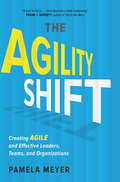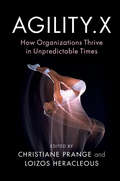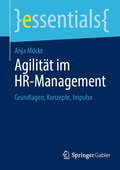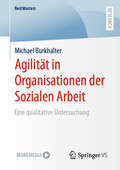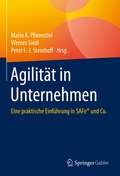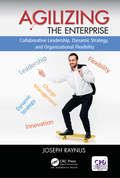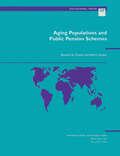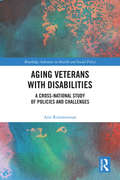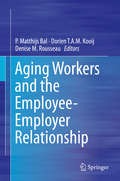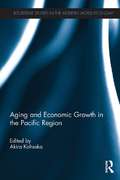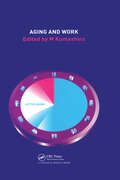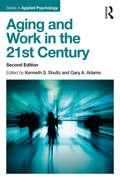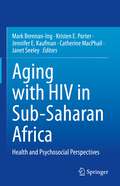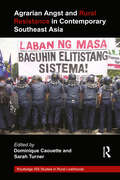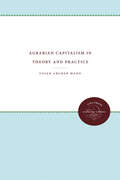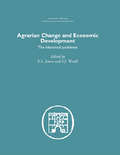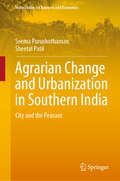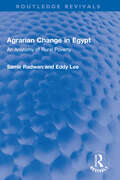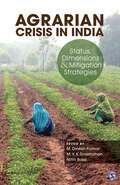- Table View
- List View
Agility Shift: Creating Agile and Effective Leaders, Teams, and Organizations
by Pamela MeyerAs contrary as it sounds, "planning" -- as we traditionally understand the term--can be the worst thing a company can do. Consider that volatile weather events disrupt trusted supply chains, markets, and promised delivery schedules. Ever-shifting geo-political tensions, as well as internal political upheaval within U.S. and global governments, derail long-planned new ventures. Technology failures block opportunities. Competitors suddenly change their product or release date; your team cannot meet the pace of innovations in your market niche, leaving you sidelined. There are myriad ways in the current business environment for a company's well-considered business plans to go awry. Most business schools continue to prepare managers to be effective in stable and predictable environments, conditions that, if they ever existed at all, are long gone. The Agility Shift shows business leaders exactly how to make the radical mindset and strategy shift necessary to create an agile, entrepreneurial organization that can innovate and thrive in complex, ever-changing contexts. As author Pamela Meyer explains, there is much more involved than a reconfiguration of the org chart and job descriptions. It requires relinquishing the illusion of control at the very foundation of most management training and business practice. Despite most leaders' approaches, "Agility is not simply accelerated planning." Unlike many agility books on the market, The Agility Shift provides specific, actionable strategies and tactics for leaders at all levels of the organization to put into practice immediately to improve agility and achieve results.
Agility.X: How Organizations Thrive in Unpredictable Times
by Loizos Heracleous Christiane PrangeIn recent years, the concept of agility has captured the executive imagination, and leaders in a variety of industries and companies of all sizes are now searching for ideas on how to effectively utilize agile thinking. <p><p>This book provides insights on agility from world-class experts on leadership, strategy and organization, alongside seasoned practitioners who have successfully implemented agility programs for companies such as Daimler, Ford Motor Company, J. W. Thompson, Siemens, and NASA. By combining theoretical expertise with a variety of managerial experiences, it provides a wide-ranging yet succinct guide for companies seeking to engage in the transformative journey towards becoming more agile. As such, it will be of great use and interest to executives in all industries, executive education participants and consultants, M.B.A. students and researchers interested in agile. Agility.X prepares leaders for managing under uncertainty and organizations for thriving in turbulent environments. Combines theoretical expertise with a variety of managerial experiences, presenting a lively, readable account for practitioners interested in learning about 'real-life' agility, backed up with substantial conceptual foundations to ignite thinking. Includes interviews with top executives from a variety of industries, giving practical insights into the ways in which executives deal with agility challenges. Combines insights from a wide range of managerial functions and perspectives, such as control, branding, and leadership, illustrating the importance of a multi-functional view of agility
Agilität im HR-Management: Grundlagen, Konzepte, Impulse (essentials)
by Anja MückeDieses essential gibt einen Überblick zu Agilität im Unternehmenskontext und zeigt deren Relevanz für das HR-Management auf. Es stellt die wichtigsten agilen Prinzipien, Begrifflichkeiten und Methoden vor. Am Beispiel von Rekrutierung, Personalentwicklung und Performance Management skizziert die Autorin, welche konkreten Anforderungen und Ansatzpunkte sich daraus für die Gestaltung von HR-Prozessen und -Instrumenten ableiten und wie die HR-Organisation selbst agiler aufgestellt und gestaltet werden kann. Damit liefert dieses essential Orientierung und Hilfestellung dabei, die aktuelle Agilitätsdebatte für die eigene HR-Arbeit einzuordnen. Der Inhalt Einführung in Agilität: Historie, Prinzipien, Begrifflichkeiten & Methoden Agilität im HR-Management: HR als Transformationsförderer und -begleiter, agile HR-Prozesse und Instrumente, Agilität in der HR-Organisation Die Zielgruppen Praktiker*innen im HR und Management aus Unternehmen Studierende der Betriebswirtschaftslehre/Betriebsökonomie mit Schwerpunkt HR/Personal
Agilität in Organisationen der Sozialen Arbeit: Eine qualitative Untersuchung (BestMasters)
by Michael BurkhalterIn dem vorliegenden Buch wird Agilität in Organisationen der Sozialen Arbeit untersucht und der Fragestellung nachgegangen, inwiefern eine agile Projektmanagementmethode wie Scrum auf Organisationen der Sozialen Arbeit übertragen werden kann. Durch komplexe Einflüsse aus Umwelt und Gesellschaft werden neue Herausforderungen an die Soziale Arbeit sowie deren Organisationen herangetragen, die einen veränderten Umgang zur Bearbeitung sozialer Probleme erfordern. Agilität bietet als ganzheitliches Konzept einen Lösungsansatz, um in einer veränderten Form reagieren zu können. Dies geht mit einer Vielzahl agiler Methodiken einher. Die qualitative Untersuchung zeigt, dass Agilität organisationale Bedingungen und Logiken erfordert. Sowohl das individuelle Mindset, die Kultur und Strukturen der Organisation sowie das Leadership müssen berücksichtigt werden. Nicht zuletzt leistet die Untersuchung mehrere Ansätze und praktische Herangehensweisen, mit denen, beispielsweise durch den Modellversuch «socialScrum», Agilität in Organisationen der Sozialen Arbeit bei der Bearbeitung sozialer Probleme gelingen kann.
Agilität in Unternehmen: Eine praktische Einführung in SAFe® und Co.
by Mario A. Pfannstiel Peter F.-J. Steinhoff Werner SiedlDas Herausgeberwerk vermittelt fundiert und praxisnah, wie Unternehmen durch Agilität mit dem SAFe® (Scaled Agile Framework®) und Co. schnell und auf innovative Weise auf die Digitalisierung und die Kunden- und die Marktveränderungen reagieren, um in einem proaktiven Handeln künftige Entwicklungen vorwegnehmen zu können.SAFe® verbindet den Mehrwert der beiden strategischen Managementansätze von „lean“ und „agil“ und sichert Unternehmen durch ein duales Betriebssystem die Zukunft. Die heutigen effizienten und stabilen Strukturen werden durch einen schnellen und innovativen Value Stream (Wertstrom) ergänzt und ein Unternehmen wird auf die Säulen von Business-Agilität, Organisationsagilität und Technologieagilität gestellt. In den einzelnen Beiträgen werden neben einer theoretischen Einführung in die Agilität auch zahlreiche praktische Umsetzungsbeispiele aus verschiedenen Branchen aufgezeigt und konkrete Handlungsempfehlungen für Unternehmen gegeben.Das Buch richtet sich an Praktiker, die sich mit der agilen Transformation von Unternehmen beschäftigen, an Transformationsverantwortliche, Business-Verantwortliche, Agile Coaches, Geschäftsführer und andere Entscheidungsträger. Es richtet sich auch an Wissenschaftler und Dozenten mit den Schwerpunktfächern Organisation, Agiles Management, Projektmanagement, Business Management, Change Management, Produktmanagement, Entwicklung, Prozessmanagement und Strategisches Management. Mit einem Geleitwort von Dean Leffingwell
Agilizing the Enterprise
by Joseph RaynusAre you still searching for the workplace that deserves someone like you? Do you really have a good understanding about what is going on out there, in the business world? In this book, we will discuss the importance of agility and how it affects the solutions that are being delivered by an organization. We will also talk about how a blend of strategic innovation, visionary leadership, and organizational agility go hand in hand to ensure the success of an organization. Enterprise agility is not a far-fetched possibility. Once the problems of the organization are identified, with the right tools and effort, the agility, efficiency, and effectiveness of an organization, as well as the processes that the success of the organization are based on, can all be maximized. This book will broaden your thinking and will help you expand your horizons.
Aging Populations and Public Pension Schemes (Occasional Papers #Occasional Paper No. 147)
by Albert Jaeger Sheetal K. ChandAn aging society is characterized by a growing proportion of the retired to the active working population. Societies age either when fertility rates decline so that fewer children are born, or when longevity increases, or both. Aging affects virtually all societies today, but more so the industrial countries, which have generally experienced it over a longer period and for which further pronounced aging is projected over the next four decades, at the end of which a peak in the proportion of the elderly is likely to be attained. Concerns about the challenges posed by aging populations have moved to the forefront of the public policy debate in many countries. This paper attempts to respond to some of these concerns, focusing in particular on the fiscal sustainability of public pension schemes in industrial countries.
Aging Veterans with Disabilities: A Cross-National Study of Policies and Challenges
by Arie RimmermanThe number of older war veterans receiving disability benefits is steadily growing and is predicted to rise in the next decade. This book provides comprehensive knowledge about health and psychosocial concerns of veterans aging with disabilities and unmet needs and compares policy in three countries that have been involved in massive warfare in the 20th century––the United Kingdom (UK), the United States (US), and Israel. Using a cross-national comparative study of the policies, legislation and services provided by these three countries, which have significant numbers of aging disabled military veterans, this book provides evidence-based knowledge on the trajectories and attendant mental-health and psychosocial problems this sub-group faces when aging with a disability. It sheds light on the paradox in which most veterans with disabilities in the UK, USA and Israel are older, while the current legislation and budget target younger veterans with disabilities. The book reflects the current debate regarding the desired policy toward older veterans with disabilities in these countries and whether to provide them with proactive health services prior to retirement to prevent "accelerated aging". It also evaluates the dilemma of whether to serve aging veterans separately as a unique population or to provide them with the same services used by the general population. This book will be of interest to all academics and students working in disability studies, rehabilitation studies, gerontology, psychology, sociology, social work, social policy, and law more broadly.
Aging Workers and the Employee-Employer Relationship
by Denise M. Rousseau P. Matthijs Bal Dorien T.A.M. KooijThis book focuses on the aging workforce from the employment relationship perspective. This innovative book specifically focuses on how organizations can ensure their aging workers remain motivated, productive and healthy. In 15 chapters, several experts on this topic describe how organizations through effective human resource management can ensure that workers are able to continue working at higher age. In addition, this book discusses the role older workers themselves play in continuing work at higher age. To do this, the authors integrate research from different areas, such as literature on leadership, psychological contracts and diversity with literature on the aging workforce. Through this integration this book provides innovative ways for organizations and workers to maintain productivity, motivation and health. Aging Workers and the Employee-Employer Relationship summarizes the latest research on how employment relationships change with age and its implications for supporting the well-being, motivation and productivity of older workers. It identifies ways to improve how both companies and workers solve the problems they face. These include better designed employment practices and more adaptive job content and developmental opportunities for aging workers along with activities aging workers can engage to enhance their own job crafting, learning and employability.
Aging and Economic Growth in the Pacific Region (Routledge Studies in the Modern World Economy)
by Akira KohsakaThe Pacific region is in the final stage of the demographic transition with declining fertility and expanding life expectancy, where significant changes in population size and age distribution, i.e. "aging" have been and will be witnessed. They are unprecedented and going to affect economic growth in various ways. This book focuses on the Pacific region, one of the most rapidly aging regions, and examines the possible risk aspects. Particularly, the book takes into account of possible adjustments both endogenous and exogenous (including policy responses) to the new reality of aging population. It also assesses their quantitative influences on the growth impact of aging population, which might be very different from those in the past experience.The book highlights the doubts on the steadiness across periods and similarities across economies of parameters relevant to labor market participation, saving and investment of private sectors, and productivity growth, which a bulk of prior studies were crucially based on. Policy measures to enhance labor supply, domestic savings and productivity have been scrutinized. The book discusses the policy alternatives in practice and their implementations and/or planning of each category across regional economies.
Aging and Social Expenditure in the Major Industrial Countries, 1980-2025
by Peter S. Heller Richard Hemming Peter W. KohnertFinancial report from the IMF
Aging and Work
by Masaharu KumashiroImprovements in health care and quality of life in recent years have led to a marked aging of the world's population, especially in well-developed regions. In the near future, this problem will spread to developing countries. The growing need to promote the health and function of aging workers presents new challenges as well as new opportunities.
Aging and Work in the 21st Century (Applied Psychology Series)
by Kenneth S. Shultz Gary A. AdamsAging and Work in the 21st Century, 2nd edition, reviews, summarizes, and integrates existing literature from various disciplines with regard to aging and work, but with a focus on recent advances in the field. Chapter authors, all leading experts within their respective areas, provide recommendations for future research, practice, and/or public policy. Fully revised and updated, the second edition takes up many of the same critical topics addressed in the first edition, and incorporates twelve new authors across the volume and three brand new chapters on recruitment and retention, legal issues, and global issues in work and aging. The intended audience is advanced undergraduate and graduate students, as well as researchers in the disciplines of industrial and organizational psychology; developmental psychology; gerontology; sociology; economics; and social work. Older worker advocate organizations, such as AARP, will also take interest in this edited book.
Aging in the Asian "Tigers": Challenges for Fiscal Policy 1
by Peter S. HellerFinancial report from the IMF
Aging with HIV in Sub-Saharan Africa: Health and Psychosocial Perspectives
by Catherine MacPhail Janet Seeley Mark Brennan-Ing Kristen E. Porter Jennifer E. KaufmanWith the development of effective antiretroviral therapies (ART) in the mid-1990s, HIV became a treatable although serious condition, and people who are adherent to HIV medications can attain normal or near-normal life expectancies. Because of the success of ART, people 50 and older now make up a majority of people with HIV in high-income countries and other places where ART is accessible. The aging of the HIV epidemic is a global trend that is also being observed in low- and middle-income countries, including countries in sub-Saharan Africa, where the greatest number of older people with HIV reside (3.7 million). While globally over half of older adults with HIV are in sub-Saharan Africa, we have little information about the circumstances, needs, and resiliencies of this population, which limits our ability to craft effective policy and programmatic responses to aging with HIV in this region. At present, our understanding of HIV and aging is dominated by information from the U.S. and Western Europe, where the epidemiology of HIV and the infrastructure to provide social care are markedly different than in sub-Saharan Africa. Aging with HIV in Sub-Saharan Africa addresses this gap in our knowledge by providing current research and perspectives on a range of health and psychosocial topics concerning these older adults from across this region. This volume provides a unique and timely overview of growing older with HIV in a sub-Saharan African context, covering such topics as epidemiology, health and functioning, and social support, as well as policy and program implications to support those growing older with HIV. There are very few published volumes that address HIV and aging, and this is the first book to consider HIV and aging in sub-Saharan Africa. Most publications in this area focus on HIV and aging in Uganda and South Africa. This volume broadens the scope with contributions from authors working in West Africa, Botswana, and Kenya. The range of topics covered here will be useful to professionals in a range of disciplines including psychology, epidemiology, gerontology, sociology, health care, public health, and social work.
Agire!
by Greyson CameronRimandare è una delle piaghe della nostra società e consiste nel rimandare scientemente e in modo non necessario azioni e decisioni. Rinviare a domani non è una scelta saggia perché nessuno sa che cosa riservi l’avvenire e quante opportunità si perderanno e poi, se noi rimandiamo, gli altri ne approfitteranno e avranno successo al nostro posto. Questo manuale insegna cosa ci spinge a rimandare, come evitare questo inconveniente, come riorganizzare i propri spazi e la propria vita per avere successo e rispetto e cura di sé con tecniche di meditazione di valorizzazione del proprio essere. Compra la tua copia cliccando sul bottone in alto sulla pagina.
Agora (A)
by Tom Quinn Thomas R. Eisenmann Lindsay N. HydeAgora was a civic technology (civic tech) startup founded by Elsa Sze, who wanted to enhance the connection between political officials and their constituents by facilitating virtual "town halls," making underrepresented voices heard and benefiting elected and appointed leaders who often struggled to collect meaningful feedback. Despite success in startup accelerator programs, challenges and complexities with government sales cycles led Sze to pivot the company multiple times, until she was selling customer service software to corporations and pondering whether she still wanted to build and sell Agora. A short financial runway meant she had to quickly decide where to invest her energy.
Agora (B)
by Tom Quinn Thomas R. Eisenmann Lindsay N. HydeThis is the conclusion to Agora (A), where founder Elsa Sze decides if she wants to continue investing energy in her civic technology startup. Agora was a civic technology (civic tech) startup founded by Elsa Sze, who wanted to enhance the connection between political officials and their constituents by facilitating virtual "town halls," making underrepresented voices heard and benefiting elected and appointed leaders who often struggled to collect meaningful feedback. Despite success in startup accelerator programs, challenges and complexities with government sales cycles led Sze to pivot the company multiple times, until she was selling customer service software to corporations and pondering whether she still wanted to build and sell Agora. A short financial runway meant she had to quickly decide where to invest her energy.
Agrarian Angst and Rural Resistance in Contemporary Southeast Asia (Routledge ISS Studies in Rural Livelihoods)
by Sarah Turner Dominique CaouetteAgrarian transformations, market integration and globalization processes are impacting upon rural Southeast Asia with increasingly complex and diverse consequences. In response, local inhabitants are devising a broad range of resistance measures that they feel will best protect or improve their livelihoods, ensure greater social justice and equity, or allow them to just be left alone. This book develops a multi-scalar approach to examine such resistance occurring in relation to agrarian transformations in the Southeast Asian region. The contributors take a fresh look at the diversity of sites of struggle and the combinations of resistance measures being utilized in contemporary Southeast Asia. They reveal that open public conflicts and debates are taking place between dominators and the oppressed, at the same time as covert critiques of power and everyday forms of resistance. The book shows how resistance measures are context contingent, shaped by different world views, and shift according to local circumstances, the opening and closing of political opportunity structures, and the historical peculiarities of resistance dynamics. By providing new conceptual approaches and illustrative case studies that cut across scales and forms, this book will be of interest to academics and students in comparative politics, sociology, human geography, environmental studies, cultural anthropology and Southeast Asian studies. It will also help to further debate and action among academics, activists and policymakers.
Agrarian Capitalism in Theory and Practice
by Susan Archer MannSusan Mann focuses on a longstanding controversy in sociological theory: why has agriculture been traditionally resistant to wage labor? Capitalist develoment has been slower and more uneven in agriculture than in other spheres of production, and major parts of the rural economy remain almost preindustrial in their reliance on family labor, lack of separation between industry and household, and failure to develop a highly specialized division of labor. Emphasizing the agriculture of the American South, Mann adopts an interdisciplinary approach, drawing insights from history and economics as well as sociology.Mann points out that most theories of agrarian capitalism -- both Marxist and non-Marxist -- ignore the implications of agriculture as a production process centered in nature, with natural features that cannot be synchronized easily into the tempos required by industrial production. She argues that various natural and technical features of agricultural production, such as the relatively lengthy production time of certain crops and the irregular labor requirements imposed by seasonal production, make some types of farming particularly risky avenues for capitalist investment.To test this pioneering theory of natural obstacles to rural capitalist development, Mann creatively combines diverse research methodologies. Analyzing U.S. Agricultural Census data, she shows the correlations between type of agricultural commodity or crop produced, the natural and technical features of these rural commodities, and the use of wage labor. Using an historical-comparative approach, she investigates the persistence of nonwage labor in American cotton production after the Civil War. She examines why sharecropping, rather than wage labor, replaced slavery in the older cotton-producing regions of the southeastern United States. She then discusses the domestic and international factors that finally led to the demise of sharecropping and the rise of wage labor in the decades following the Great Depression.In this historical study of the rise and demise of sharecropping, the interplay between nature, gender, race, and class is highlighted. By closely examining both natural and social obstacles to wage labor within the context of a global economy, Mann presents not only an intriguing analysis of agrarian capitalist development but also an entirely new framework for examining the social history of the American South.Originally published in 1990.A UNC Press Enduring Edition -- UNC Press Enduring Editions use the latest in digital technology to make available again books from our distinguished backlist that were previously out of print. These editions are published unaltered from the original, and are presented in affordable paperback formats, bringing readers both historical and cultural value.
Agrarian Change and Economic Development: The Historical Problems
by E. L. Jones S. J. WoolfAgrarian Change and Economic Development is a landmark volume that examines the historical experience of the relationship between agrarian change and economic development. Because agriculture was until recently man's dominant occupation, scholars have traditionally drawn little attention to its immense historical importance. The essays in this book redress this balance, and illustrate the significance of the western world's escape from an overwhelmingly agrarian condition. It is therefore an ideal work for encouraging those concerned with current problems to perceive agricultural development as professional historians see it, and to question the oversimplified historical analogies commonly employed in development economics. Presenting historical examples of change within particular agricultural systems, and discussing their implications for national economic development, both social scientists and planners less concerned with historical revision will have equal reason to welcome these case studies of the long-run interaction of agrarian change and economic activity. This classic book was first published in 1969.
Agrarian Change and Urbanization in Southern India: City and the Peasant (India Studies in Business and Economics)
by Seema Purushothaman Sheetal PatilThis book takes readers on a journey through the evolution of agricultural communities in southern India, from their historical roots to the recent global neo-liberal era. It offers insights into a unique combination of themes, with a particular focus on agrarian change and urbanisation, specifically in the state of Karnataka where both aspects are significant and co-exist. Based on case studies from Karnataka in South India, the book presents a regional yet integrated multi-disciplinary framework for analysing the persistence, resilience and future of small farmer units. In doing so, it charts possible futures for small farm holdings and identifies means of integrating their progress and sustainability alongside that of the rest of the economy. Further, it provides arguments for the relevance of small holdings in connection with sustainable livelihoods and welfare at the grass roots, while also catering to the welfare needs of society at the macro level. The book makes a valuable contribution to the scholarship of agrarian as well as peri-urban transdisciplinary literature. For agrarian academics, students and the teaching community, the book’s broad and topical coverage make it a valuable resource. For development practitioners and for those working on issues related to urbanisation, urban peripheries and the rural–urban interface, this book offers a new perspective that considers the primary sector on par with the secondary and tertiary. It also offers an insightful guide for policymakers and non-government organisations working in this area.
Agrarian Change in Egypt: An Anatomy of Rural Poverty (Routledge Revivals)
by Samir Radwan Eddy LeeFirst published in 1986, Agrarian Change in Egypt based on extensive original research as well as field survey of eighteen villages, analyses and explains the changes in the agricultural sector in Egypt. It shows how various policies and other factors have affected agricultural output and how developments triggered by the ‘open door policy’ such as inflation, migration, and the shift in the pricing system have affected agriculture. The Egyptian experience is fairly typical of agrarian change in many parts of the developing world where government reforms in the 1960s and 1970s tried to combine considerations of efficiency and equity but ended up with stagnation. The Egyptian case therefore provides a good example of the general crisis in agriculture in the developing world. This book is an essential read for scholars and researchers of agricultural economy, development studies and political economy.
Agrarian Crisis in India: Status, Dimensions and Mitigation Strategies
by M. Dinesh Kumar Nitin Bassi M. V. K. SivamohanAgrarian Crisis in India: Status, Dimensions and Mitigation Strategies looks at India’s agrarian crisis from the perspectives of limits induced by land scarcity and water stress, the changing dynamics with respect to costs of various inputs, and the externalities induced by changing environmental and market conditions. To understand whether the crisis is a relatively recent phenomenon or has existed before, the book analyses the situation from a historical perspective. The book studies the primary factors driving annual agricultural growth rates and discusses whether there are more factors that determine short-term growth rates and to what extent they can influence the long-term growth. As livestock has a major role in making the farming system resilient, the book covers livestock rearing and dairy farming in detail. It examines the risk implications of the changing characteristics of farming systems, analyses existing strategies for supporting irrigation development and promoting productivity, and suggests some key policy measures for improving growth in different agro-ecologies.
